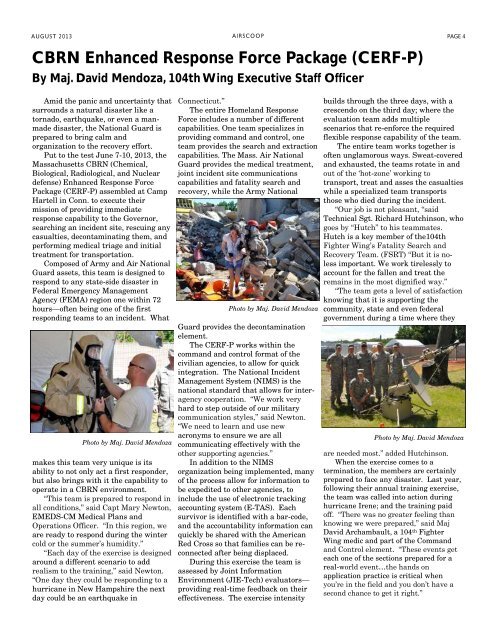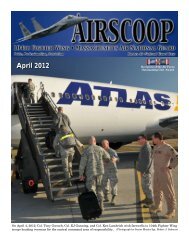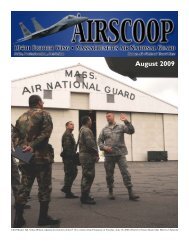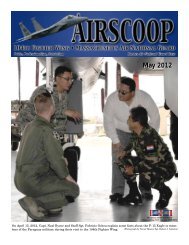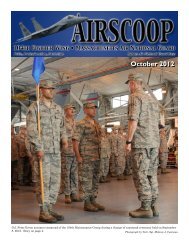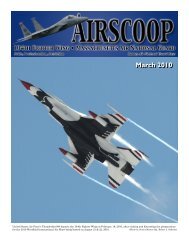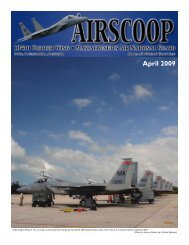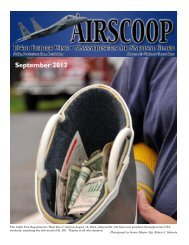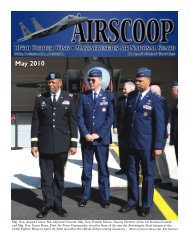August 2013 (pdf) - 104th Fighter Wing, Massachusetts Air National ...
August 2013 (pdf) - 104th Fighter Wing, Massachusetts Air National ...
August 2013 (pdf) - 104th Fighter Wing, Massachusetts Air National ...
You also want an ePaper? Increase the reach of your titles
YUMPU automatically turns print PDFs into web optimized ePapers that Google loves.
AUGUST <strong>2013</strong><br />
AIRSCOOP<br />
PAGE 4<br />
CBRN Enhanced Response Force Package (CERF-P)<br />
By Maj. David Mendoza, <strong>104th</strong> <strong>Wing</strong> Executive Staff Officer<br />
Amid the panic and uncertainty that<br />
surrounds a natural disaster like a<br />
tornado, earthquake, or even a manmade<br />
disaster, the <strong>National</strong> Guard is<br />
prepared to bring calm and<br />
organization to the recovery effort.<br />
Put to the test June 7-10, <strong>2013</strong>, the<br />
<strong>Massachusetts</strong> CBRN (Chemical,<br />
Biological, Radiological, and Nuclear<br />
defense) Enhanced Response Force<br />
Package (CERF-P) assembled at Camp<br />
Hartell in Conn. to execute their<br />
mission of providing immediate<br />
response capability to the Governor,<br />
searching an incident site, rescuing any<br />
casualties, decontaminating them, and<br />
performing medical triage and initial<br />
treatment for transportation.<br />
Composed of Army and <strong>Air</strong> <strong>National</strong><br />
Guard assets, this team is designed to<br />
respond to any state-side disaster in<br />
Federal Emergency Management<br />
Agency (FEMA) region one within 72<br />
hours—often being one of the first<br />
responding teams to an incident. What<br />
Photo by Maj. David Mendoza<br />
makes this team very unique is its<br />
ability to not only act a first responder,<br />
but also brings with it the capability to<br />
operate in a CBRN environment.<br />
“This team is prepared to respond in<br />
all conditions,” said Capt Mary Newton,<br />
EMEDS-CM Medical Plans and<br />
Operations Officer. “In this region, we<br />
are ready to respond during the winter<br />
cold or the summer’s humidity.”<br />
“Each day of the exercise is designed<br />
around a different scenario to add<br />
realism to the training,” said Newton.<br />
“One day they could be responding to a<br />
hurricane in New Hampshire the next<br />
day could be an earthquake in<br />
Connecticut.”<br />
The entire Homeland Response<br />
Force includes a number of different<br />
capabilities. One team specializes in<br />
providing command and control, one<br />
team provides the search and extraction<br />
capabilities. The Mass. <strong>Air</strong> <strong>National</strong><br />
Guard provides the medical treatment,<br />
joint incident site communications<br />
capabilities and fatality search and<br />
recovery, while the Army <strong>National</strong><br />
Photo by Maj. David Mendoza<br />
Guard provides the decontamination<br />
element.<br />
The CERF-P works within the<br />
command and control format of the<br />
civilian agencies, to allow for quick<br />
integration. The <strong>National</strong> Incident<br />
Management System (NIMS) is the<br />
national standard that allows for interagency<br />
cooperation. “We work very<br />
hard to step outside of our military<br />
communication styles,” said Newton.<br />
“We need to learn and use new<br />
acronyms to ensure we are all<br />
communicating effectively with the<br />
other supporting agencies.”<br />
In addition to the NIMS<br />
organization being implemented, many<br />
of the process allow for information to<br />
be expedited to other agencies, to<br />
include the use of electronic tracking<br />
accounting system (E-TAS). Each<br />
survivor is identified with a bar-code,<br />
and the accountability information can<br />
quickly be shared with the American<br />
Red Cross so that families can be reconnected<br />
after being displaced.<br />
During this exercise the team is<br />
assessed by Joint Information<br />
Environment (JIE-Tech) evaluators—<br />
providing real-time feedback on their<br />
effectiveness. The exercise intensity<br />
builds through the three days, with a<br />
crescendo on the third day; where the<br />
evaluation team adds multiple<br />
scenarios that re-enforce the required<br />
flexible response capability of the team.<br />
The entire team works together is<br />
often unglamorous ways. Sweat-covered<br />
and exhausted, the teams rotate in and<br />
out of the ‘hot-zone’ working to<br />
transport, treat and asses the casualties<br />
while a specialized team transports<br />
those who died during the incident.<br />
“Our job is not pleasant, “said<br />
Technical Sgt. Richard Hutchinson, who<br />
goes by “Hutch” to his teammates.<br />
Hutch is a key member of the<strong>104th</strong><br />
<strong>Fighter</strong> <strong>Wing</strong>’s Fatality Search and<br />
Recovery Team. (FSRT) “But it is noless<br />
important. We work tirelessly to<br />
account for the fallen and treat the<br />
remains in the most dignified way.”<br />
“The team gets a level of satisfaction<br />
knowing that it is supporting the<br />
community, state and even federal<br />
government during a time where they<br />
Photo by Maj. David Mendoza<br />
are needed most.” added Hutchinson.<br />
When the exercise comes to a<br />
termination, the members are certainly<br />
prepared to face any disaster. Last year,<br />
following their annual training exercise,<br />
the team was called into action during<br />
hurricane Irene; and the training paid<br />
off. “There was no greater feeling than<br />
knowing we were prepared,” said Maj<br />
David Archambault, a 104 th <strong>Fighter</strong><br />
<strong>Wing</strong> medic and part of the Command<br />
and Control element. “These events get<br />
each one of the sections prepared for a<br />
real-world event…the hands on<br />
application practice is critical when<br />
you’re in the field and you don’t have a<br />
second chance to get it right.”


